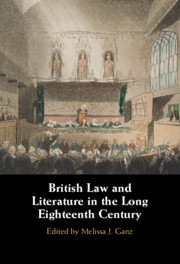Refine search
Actions for selected content:
335 results
Chapter 9 - Bridging the Juridical Gap
- from Part III - Issues across the Boundaries of Law and Morality
-
-
- Book:
- Law and Morality in Kant
- Published online:
- 16 December 2025
- Print publication:
- 22 January 2026, pp 169-192
-
- Chapter
-
- You have access
- Open access
- HTML
- Export citation
5 - Equality, Liberty, and Rights in the Declaration of Independence
-
-
- Book:
- The Cambridge Companion to the Declaration of Independence
- Print publication:
- 22 January 2026, pp 61-75
-
- Chapter
- Export citation
3 - Bad Consequences
- from Part I - The Majoritarian Critique and the Constitutionalist Response
-
- Book:
- Democracy, Liberty, and Judicial Review
- Published online:
- 05 December 2025
- Print publication:
- 08 January 2026, pp 102-114
-
- Chapter
- Export citation
Chapter 7 - Land
- from Part II - Making Improvement Material
-
- Book:
- Violent Waters
- Published online:
- 17 December 2025
- Print publication:
- 08 January 2026, pp 185-214
-
- Chapter
- Export citation
2 - Judicial Review and the Constitutionalist Conception of Democracy
- from Part I - The Majoritarian Critique and the Constitutionalist Response
-
- Book:
- Democracy, Liberty, and Judicial Review
- Published online:
- 05 December 2025
- Print publication:
- 08 January 2026, pp 57-101
-
- Chapter
- Export citation
1 - Majoritarian Arguments
- from Part I - The Majoritarian Critique and the Constitutionalist Response
-
- Book:
- Democracy, Liberty, and Judicial Review
- Published online:
- 05 December 2025
- Print publication:
- 08 January 2026, pp 19-56
-
- Chapter
- Export citation

Charity After Empire
- British Humanitarianism, Decolonisation and Development
-
- Expected online publication date:
- December 2025
- Print publication:
- 28 February 2026
The Right to Freedom
-
- Journal:
- Kantian Review , First View
- Published online by Cambridge University Press:
- 11 December 2025, pp. 1-21
-
- Article
-
- You have access
- Open access
- HTML
- Export citation

Democracy, Liberty, and Judicial Review
-
- Published online:
- 05 December 2025
- Print publication:
- 08 January 2026
Entangled harms: A reparative approach to climate justice
-
- Journal:
- Leiden Journal of International Law , First View
- Published online by Cambridge University Press:
- 21 November 2025, pp. 1-22
-
- Article
-
- You have access
- Open access
- HTML
- Export citation
1 - The Emerging Crisis (to December 1964)
-
- Book:
- Waging Peace
- Published online:
- 03 November 2025
- Print publication:
- 13 November 2025, pp 8-38
-
- Chapter
- Export citation
Constitutional subjects: the formation and fracture of constitutional legitimacy. Towards a phenomenology of law and violence
-
- Journal:
- European Law Open ,
- Published online by Cambridge University Press:
- 10 November 2025, pp. 1-25
-
- Article
-
- You have access
- Open access
- HTML
- Export citation
Private Right and Public Right
-
- Journal:
- Canadian Journal of Law & Jurisprudence , First View
- Published online by Cambridge University Press:
- 24 October 2025, pp. 1-13
-
- Article
-
- You have access
- Open access
- HTML
- Export citation
Introduction
-
-
- Book:
- British Law and Literature in the Long Eighteenth Century
- Published online:
- 19 September 2025
- Print publication:
- 09 October 2025, pp 1-24
-
- Chapter
- Export citation
8 - Plurinational Juristocracy and Rights from Below at Bolivia’s Gas Frontier
-
-
- Book:
- Reckoning with Law in Excess
- Published online:
- 09 September 2025
- Print publication:
- 25 September 2025, pp 186-211
-
- Chapter
-
- You have access
- Open access
- HTML
- Export citation

British Law and Literature in the Long Eighteenth Century
-
- Published online:
- 19 September 2025
- Print publication:
- 09 October 2025
Abstraction and Determination in Weinrib’s Reciprocal Freedom: The Dynamics of Backward-Looking and Forward-Looking Deliberation in Judging
-
- Journal:
- Canadian Journal of Law & Jurisprudence , First View
- Published online by Cambridge University Press:
- 09 September 2025, pp. 1-10
-
- Article
-
- You have access
- Open access
- HTML
- Export citation
How Capacious is the Kantian System of Rights?
-
- Journal:
- Canadian Journal of Law & Jurisprudence , First View
- Published online by Cambridge University Press:
- 09 September 2025, pp. 1-13
-
- Article
-
- You have access
- Open access
- HTML
- Export citation
The Deliberative Democratic Turn In Human Rights
- Part of
-
- Journal:
- Federal Law Review / Volume 53 / 2025
- Published online by Cambridge University Press:
- 03 September 2025, e1
-
- Article
-
- You have access
- Open access
- HTML
- Export citation
The Place of Federalism in Deliberative Rights Theory
- Part of
-
- Journal:
- Federal Law Review / Volume 53 / 2025
- Published online by Cambridge University Press:
- 03 September 2025, e5
-
- Article
-
- You have access
- Open access
- HTML
- Export citation
